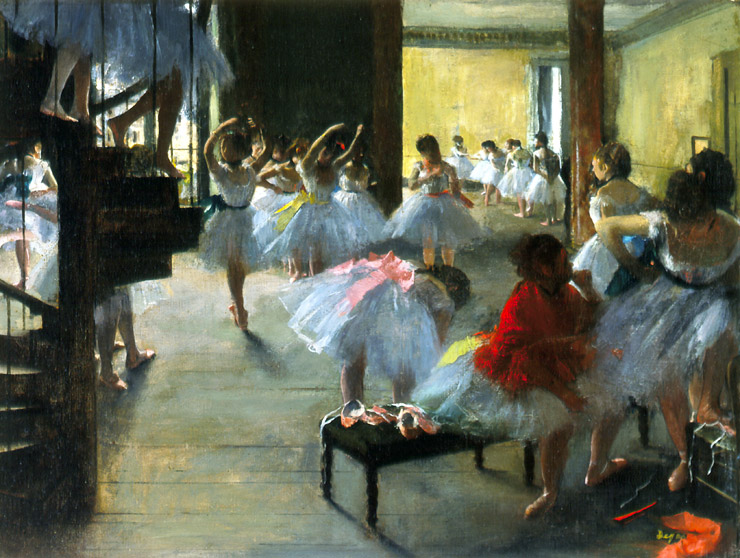Title goes here

Little Dancer Aged Fourteen, 1878–1881pigmented beeswax, clay, metal armature, rope, paintbrushes, human hair, silk and linen ribbon, cotton and silk tutu, linen slippers, on wooden base
overall without base: 98.9 x 34.7 x 35.2 cm (38 15/16 x 13 11/16 x 13 7/8 in.) weight: 49 lb. (22.226 kg)
National Gallery of Art, Washington, Collection of Mr. and Mrs. Paul Mellon

Study in the Nude of Little Dancer Aged Fourteen (Nude Little Dancer), c. 1878–1881pigmented beeswax, plaster core, metal and wood armatures, on plaster and wooden bases
overall without base: 69.5 x 29.3 x 30.3 cm (27 3/8 x 11 9/16 x 11 15/16 in.) overall (wood base): 3.5 x 48 x 31.1 cm (1 3/8 x 18 7/8 x 12 1/4 in.)
overall (plaster base): 5 x 34.6 x 26.8 cm (1 15/16 x 13 5/8 x 10 9/16 in.)
National Gallery of Art, Washington, Collection of Mr. and Mrs. Paul Mellon

Fourth Position Front, on the Left Leg, c. 1885/1890pigmented beeswax, metal armature, cork, on wooden base
overall without base: 60.3 x 37.8 x 34.1 cm (23 3/4 x 14 7/8 x 13 7/16 in.)
height (of figure): 56.8 cm (22 3/8 in.)
Collection of Mr. and Mrs. Paul Mellon

The Dance Lesson, c. 1879oil on canvas, overall: 38 x 88 cm (14 15/16 x 34 5/8 in.)
framed: 59.7 x 108.3 x 5.1 cm (23 1/2 x 42 5/8 x 2 in.)
National Gallery of Art, Washington, Collection of Mr. and Mrs. Paul Mellon

The Dance Class (Ecole de Danse), c. 1873oil on canvas, 47.6 x 62.2 cm (18 3/4 x 24 1/2 in.)
Trustees of the Corcoran Collection (William A. Clark Collection)
The Curtain, c. 1880pastel over charcoal and monotype on laid paper mounted on board
sheet: 29 x 33.3 cm (11 7/16 x 13 1/8 in.)
National Gallery of Art, Washington, Collection of Mr. and Mrs. Paul Mellon

Ballet Dancers, c. 1877pastel and gouache over monotype
overall: 29.7 x 26.9 cm (11 11/16 x 10 9/16 in.)
framed: 46.6 x 43.5 x 6.3 cm (18 3/8 x 17 1/8 x 2 1/2 in.)
National Gallery of Art, Washington, Ailsa Mellon Bruce Collection

Dancers at the Old Opera House, c. 1877pastel over monotype on laid paper
overall: 21.8 x 17.1 cm (8 9/16 x 6 3/4 in.)
framed: 35.5 x 31.1 x 3.8 cm (14 x 12 1/4 x 1 1/2 in.)
National Gallery of Art, Washington, Ailsa Mellon Bruce Collection

Ballet Scene, c. 1907pastel on greenish transparent tracing paper
overall: 76.8 x 111.2 cm (30 1/4 x 43 3/4 in.)
National Gallery of Art, Washington, Chester Dale Collection

Paul MatheyEdgar Degas, 1882graphite on paperboard
overall: 48.2 x 31.5 cm (19 x 12 3/8 in.)
National Gallery of Art, Washington, Collection of Mr. and Mrs. Paul Mellon

Dancer Seen from Behind and Three Studies of Feet, c. 1878black chalk and pastel on blue-gray laid paper
overall: 45.6 x 59.8 cm (17 15/16 x 23 9/16 in.)
National Gallery of Art, Washington, Gift of Myron A. Hofer in memory of his mother, Mrs. Charles Hofer

Edgar Degas, executed in collaboration with Vicomte Ludovic Napoléon LepicThe Ballet Master (Le maître de ballet), c. 1874monotype heightened and corrected with white chalk or wash
plate: 56.5 x 70 cm (22 1/4 x 27 9/16 in.)
sheet: 62 x 85 cm (24 7/16 x 33 7/16 in.)
National Gallery of Art, Washington, Rosenwald Collection